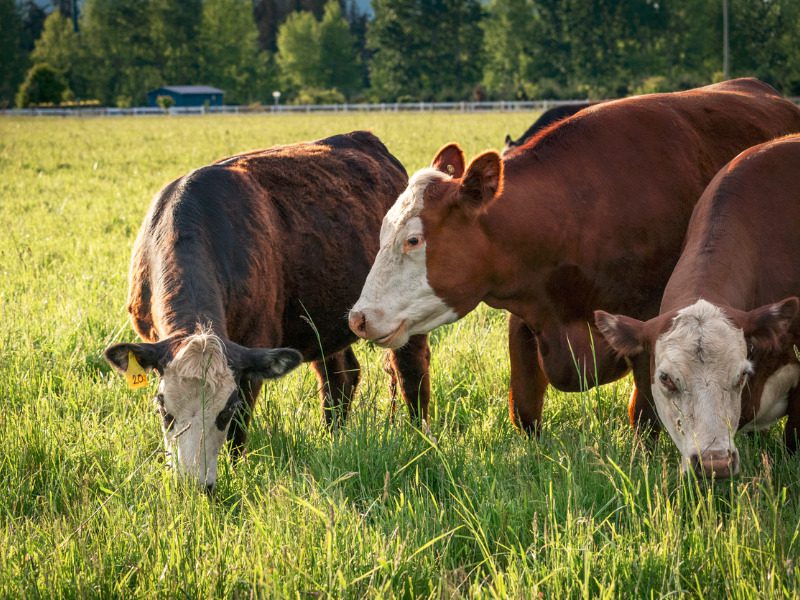How cattle will help manage B.C. wildfire risk

A handful of ranchers in British Columbia’s Interior are getting ready to graze their cattle in concentrated areas near homes and community infrastructure, where they’ll eat the grasses that dry over the summer and heighten the wildfire risk.
As part of a pilot program led by the B.C. Cattlemen’s Association, ranchers around Kelowna, Peachland, Summerland and Cranbrook will corral their cattle in targeted areas for two to three weeks, explained general manager Kevin Boon.
The cattle eat grasses that could serve as potential fuel for fires, which promotes new, green growth that doesn’t burn with the speed and intensity of grasses left to grow taller, drier and more likely to catch brush and trees on fire, he said.
“So, if we can keep that fine fuel down … it won’t burn with the heat, the intensity or the speed and we’ve got a better chance of controlling it.”
The B.C. government contributed $500,000 in 2019 to help launch the pilot project. Targeted grazing is not a solution to all fuel management challenges, the province said in a statement at the time, but “it is a powerful tool when used in combination with other methods, such as prescribed burning and selective tree harvesting.”
Amanda Miller, an ecologist who’s working as a researcher on the grazing project, said the idea stemmed from the severe 2017 and 2018 wildfire seasons, which each saw more than 12,000 square kilometres of forests and land burn.
“We’ve found time and time again, as a fire comes through, that often it will meet a fence line to a pasture that had just been grazed and the fire will stop,” Miller said.
“So, anecdotally, I think we’ve always known this, but of course you do need actual data and science to back up any recommendations that you’re making.”
Boon said he hopes the pilot project can serve as a model to scale up across B.C. in partnership with the province, ranchers and local communities.
The remains of a large structure and vehicles destroyed by the Lytton Creek wildfire are seen on the side of the Trans-Canada Highway near Lytton, B.C., on Sunday, August 15, 2021. THE CANADIAN PRESS/Darryl Dyck
In the last two seasons, each grazing site typically saw around a 30 per cent reduction in grassy biomass, amounting to a substantial reduction in fine fuels, said Miller.
“That has impact on things like rate of spread and intensity. It just reduces those metrics and makes it easier to action a fire, if it’s moving slower and it’s not as hot.”
The program has a monitoring protocol to assess the effects of targeted grazing on the grassy and forested environments, Miller noted.
“We do have a lot of data to back up the fact that what we’re doing is not negatively impacting the ecosystem,” she said.
That was still the case in one area where cattle were able to eat 40 per cent of the grassy biomass last year, she added.
Cattle are also useful in grazing areas where forests have been thinned out to reduce the risk of a dangerous crown fire, where the entire length of a tree burns. Miller said it’s harder to fight and control a wildfire when the entire tree canopy is set ablaze.
Grasses flourish as more sunlight reaches the forest floor, but they dry out and become tinder, raising the risk of a potential wildfire spark, she said.
“We use cattle to address that fine fuel concern, so you’ve hit your wildfire risk in two different ways. You’ve removed some of the danger associated with those overstorey canopies, and then you have a complementary tool in targeted grazing.”
After two years of below-average fire activity in B.C., the 2021 season saw more than 1,600 fires scorch close to 8,700 square kilometres of land.
Much of the Village of Lytton was destroyed by fire just one day after the temperature in the community southwest of Kamloops hit an all-time Canadian high of 49.6 C. Fires also razed properties between Kamloops and Vernon, and near West Kelowna.
Boon said the scorching late-June heat dome dried out the land, creating the right conditions for a destructive wildfire season.
“We’ve seen these things happen before,” he said of the fires, extreme heat and floods in B.C. last year. “Just not with the intensity and not one on top of the other.”
This year’s provincial budget allocated $145 million for B.C.’s wildfire and emergency management services through 2025 with the goal of moving from a reactive to a proactive approach to wildfires, including increases in year-round staffing.
At a news conference last month, the director of provincial operations for the wildfire service said B.C. needs a large-scale program to reduce risk, starting in backyards, moving to communities and extending into forested lands.
Feature image by iStock.com/davemantel







